Biology > QUESTIONS & ANSWERS > Chapter 17—PROCESSES OF EVOLUTION. All Answers (All)
Chapter 17—PROCESSES OF EVOLUTION. All Answers
Document Content and Description Below
Multiple Choice 1. New alleles arise by a. mutation. b. migration. c. genetic drift. d. random mating. e. independent assortment. : a POINTS: 1 REFERENCES: Section 17.1... What is microevolution? KEYWORDS: Bloom's: Remember 2. Mutations that neither harm nor help an organism are called a. dominant. b. null. c. standard. d. neutral. e. recessive. : d POINTS: 1 REFERENCES: Section 17.1 What is microevolution? KEYWORDS: Bloom's: Remember NOTES: Modified 3. The maintenance of Hardy-Weinberg equilibrium is encouraged a. when sexual selection occurs. b. when mutations occur. c. in small populations. d. when there is no gene flow among different populations. e. when mating is controlled. : d POINTS: 1 REFERENCES: Section 17.2 How do we know when a population is evolving? KEYWORDS: Bloom's: Remember NOTES: Modified 4. According to the Hardy-Weinberg law, if the frequency of a recessive allele is 36 percent, the frequency of the dominant allele would be what percent? a. 5 b. 8 c. 25 d. 48 e. 64 : e POINTS: 1 REFERENCES: Section 17.2 How do we know when a population is evolving? KEYWORDS: Bloom's: Remember NOTES: Modified 5. In the Hardy-Weinberg equation, the term q2 refers to the frequency of a. a recessive allele of a given locus. b. the frequency of a homozygous recessive genotype at a given locus. c. the frequency of all recessive alleles in a population. d. the frequency of a heterozygous genotype at a given locus. e. the frequency of a homozygous dominant genotype at a given locus. : b POINTS: 1 REFERENCES: Section 17.2 How do we know when a population is evolving? KEYWORDS: Bloom's: Remember NOTES: Modified 6. In a population that is in Hardy-Weinberg equilibrium, the frequency of the homozygous dominant genotype is 0.49. The percentage of the population that is heterozygous is a. 51. b. 49. c. 42. d. 7. e. 3. : c POINTS: 1 REFERENCES: Section 17.2 How do we know when a population is evolving? KEYWORDS: Bloom's: Remember NOTES: Modified 7. The fact that the average human birthweight remains at about seven pounds is due to a. modern prenatal care. b. the forces of stabilizing selection. c. conscious effort on the part of mothers. d. the limitations of food sources. e. selection tendencies moving in the direction of increasing birthweight. : b POINTS: 1 REFERENCES: Section 17.5 What types of natural selection favor intermediate or extreme forms of traits? KEYWORDS: Bloom's: Remember NOTES: Modified 8. In a certain bird species, clutch size (the number of eggs laid by a female in one breeding season) ranges from four to eight, and the most frequent clutch size is six. This phenomenon is an example of a. sexual selection. b. stabilizing selection. c. disruptive selection. d. directional selection. e. artificial selection. : b POINTS: 1 REFERENCES: Section 17.5 What types of natural selection favor intermediate or extreme forms of traits? KEYWORDS: Bloom's: Remember 9. Disruptive selection favors a. the intermediate forms. b. an extreme at one end of a range of variation. c. the extremes at both ends of a range of variation. d. a greater number of individuals in the center of the bell-shaped curve. e. neutral traits. : c POINTS: 1 REFERENCES: Section 17.5 What types of natural selection favor intermediate or extreme forms of traits? KEYWORDS: Bloom's: Remember NOTES: Modified 10. The introduction of a small population onto an island that results in a limited gene pool for a population best describes a. the Hardy-Weinberg law. b. genetic drift. c. the bottleneck effect. d. the founder effect. e. the effect of genetic isolation. : d POINTS: 1 REFERENCES: Section 17.7 What mechanisms other than natural selection affect allele frequencies? KEYWORDS: Bloom's: Remember 11. The sharp reduction of the gene pool and the numbers of a population through a severe epidemic is an example of a. artificial selection. b. genetic isolation. c. the bottleneck effect. d. the founder effect. e. natural selection. : c POINTS: 1 REFERENCES: Section 17.7 What mechanisms other than natural selection affect allele frequencies? KEYWORDS: Bloom's: Understand NOTES: Modified 12. The influence of genetic drift on allele frequencies increases as a. gene flow increases. b. population size decreases. c. mutation rate decreases. d. the number of heterozygous loci increases. e. population size increases. : b POINTS: 1 REFERENCES: Section 17.7 What mechanisms other than natural selection affect allele frequencies? KEYWORDS: Bloom's: Understand NOTES: Modified 13. What accounts for the fact that polydactylism is prevalent and Tay-Sachs disease is virtually absent in one human population in the United States, while Tay-Sachs disease is prevalent and polydactylism is virtually absent in another? a. Natural selection has promoted these differences since humans live in many different environments. b. Mutation rates differ among different loci. c. There is little gene flow between the two populations. d. The populations are small, and therefore genetic drift is a major factor in the determination of allele frequencies. e. The alleles are fixed in these populations. : c POINTS: 1 REFERENCES: Section 17.7 What mechanisms other than natural selection affect allele frequencies? KEYWORDS: Bloom's: Understand 14. A species is composed of a. related organisms. b. a group of reproductive females. c. populations that have the potential to interbreed and produce fertile offspring. d. organisms located in the same habitat. e. all males and females in the same geographical range with the same ecological requirements. : c POINTS: 1 REFERENCES: Section 17.8 How do species attain and maintain separate identities? KEYWORDS: Bloom's: Remember 15. Complete reproductive isolation is evidence that what has occurred? a. extinction b. speciation c. polyploidy d. hybridization e. gene flow : b POINTS: 1 REFERENCES: Section 17.8 How do species attain and maintain separate identities? KEYWORDS: Bloom's: Remember 16. The primary reason for hybrid sterility is a. the inability of the hybrid to attract a mate. b. the difficulty in finding a suitable habitat in which to survive. c. that the hybrids are usually weak and have difficulty surviving to reproductive maturity. d. that hybrids cannot produce viable gametes. e. the inability of the hybrid to develop an appropriate courtship pattern. : d POINTS: 1 REFERENCES: Section 17.8 How do species attain and maintain separate identities? KEYWORDS: Bloom's: Remember 17. Some closely related species do not interbreed simply because the timing of their reproduction differs. What type of reproductive isolation is this? a. mechanical b. ecological c. temporal d. behavioral e. gamete incompatibility : c POINTS: 1 REFERENCES: Section 17.8 How do species attain and maintain separate identities? KEYWORDS: Bloom's: Apply NOTES: New 18. During a study of two closely related animals, it did not appear as though they were reproductively isolated until the possibility that their different niches could result in ____ isolation was noted. a. ecological b. gametic c. temporal d. behavioral e. mechanical : a POINTS: 1 REFERENCES: Section 17.8 How do species attain and maintain separate identities? KEYWORDS: Bloom's: Remember 19. Allopatric speciation requires a. gradual evolutionary changes. b. geographic isolation. c. polyploidy. d. adaptive radiation. e. rapid evolutionary change. : b POINTS: 1 REFERENCES: Section 17.9 What is allopatric speciation? KEYWORDS: Bloom's: Understand 20. In allopatric speciation, daughter species usually form a. abruptly. b. in proportion to the parental stock. c. rapidly, but are then reduced by environmental factors. d. gradually over rather long periods of time. e. in the same homeland. : d POINTS: 1 REFERENCES: Section 17.9 What is allopatric speciation? LEARNING OBJECTIVES: BCA.SES.11 Bloom's: knowled - Bloom's: knowledge KEYWORDS: Bloom's: Understand 21. The greatest contributor(s) to allopatric isolation is(are) a. geographical barriers. b. different ecological niches. c. polypolidy. d. hybrid inviability. e. behavioral peculiarities. : a POINTS: 1 REFERENCES: Section 17.9 What is allopatric speciation? KEYWORDS: Bloom's: Remember NOTES: Modified 22. The speciation of cichlid fishes of the same African crater lake is an example of a. divergence. b. parapatry. c. gene flow. d. allopatry. e. sympatry. : e POINTS: 1 REFERENCES: Section 17.10 Can speciation occur without a physical barrier to gene flow? KEYWORDS: Bloom's: Remember 23. Sympatric speciation through polyploidy has been a frequent phenomenon in the evolution of a. insects. b. mammals. c. bacteria. d. plants. e. fish. : d POINTS: 1 REFERENCES: Section 17.10 Can speciation occur without a physical barrier to gene flow? KEYWORDS: Bloom's: Remember 24. Which of the following can result in instant speciation? a. development of a physical barrier b. polyploidy c. increase in physical size d. change in environmental conditions e. the introduction of a new predator into an area : b POINTS: 1 REFERENCES: Section 17.10 Can speciation occur without a physical barrier to gene flow? KEYWORDS: Bloom's: Understand 25. Parapatric speciation would be expected to occur most often a. in the same homeland. b. near a common border between two populations. c. within a group of interbreeding populations. d. across obvious geographical barriers. e. by divergence from a common interbreeding population. : b POINTS: 1 REFERENCES: Section 17.10 Can speciation occur without a physical barrier to gene flow? KEYWORDS: Bloom's: Remember 26. The border across which genes can flow between two populations is called the a. contact zone. b. parapatric zone. c. zone of speciation. d. demilitarized zone. e. zone of polyploidy. : a POINTS: 1 REFERENCES: Section 17.10 Can speciation occur without a physical barrier to gene flow? KEYWORDS: Bloom's: Remember 27. The 30-cm floral tube of the flower Angraecum and the 35-cm proboscis of its hawk moth pollinator are the result of a. preadaptation. b. adaptive radiation. c. coevolution. d. convergent evolution. e. key innovation. : c POINTS: 1 REFERENCES: Section 17.11 What is macroevolution? KEYWORDS: Bloom's: Understand NOTES: Modified 28. The acquisition of a key evolutionary innovation by a species gives evidence for the concept of a. uniformitarianism. b. gradualism. c. convergence. d. adaptive radiation. e. special creation. : d POINTS: 1 REFERENCES: Section 17.11 What is macroevolution? KEYWORDS: Bloom's: Remember 29. A method called _____ uses diagrams to group species based on their shared characteristics. a. taxonomy b. cladistics c. phylogeny d. comparative morphology e. exaptation : b POINTS: 1 REFERENCES: Section 17.12 Why do we study evolutionary history? KEYWORDS: Bloom's: Remember 30. A group that comprises an ancestor in which a derived trait evolved and all of its descendants is called: a. a cladogram. b. a clade. c. a monophyletic group. d. a sister group. e. a polyphyletic group. : c POINTS: 1 REFERENCES: Section 17.12 Why do we study evolutionary history? KEYWORDS: Bloom's: Remember NOTES: Modified Selecting the Exception 31. Four of the five s listed below are sources of variation in a population. Select the exception. a. mutation b. sexual reproduction c. crossing over d. independent assortment e. law of dominance : e POINTS: 1 REFERENCES: Section 17.1 What is microevolution? KEYWORDS: Bloom's: Understand OTHER: Selecting the Exception 32. Four of the five s listed below are characteristics of an unchanging, nonevolving population. Select the exception. a. random mating b. no mutations c. low survival rate d. no migration or gene flow e. infinitely large population : c POINTS: 1 REFERENCES: Section 17.2 How do we know when a population is evolving? KEYWORDS: Bloom's: Understand OTHER: Selecting the Exception 33. Four of the five s listed below are characteristics of mutations. Select the exception. a. are predictable b. can be beneficial c. are random d. can be neutral e. are heritable : a POINTS: 1 REFERENCES: Section 17.1 What is microevolution? KEYWORDS: Bloom's: Understand OTHER: Selecting the Exception NOTES: Modified 34. Four of the five s listed below are types of selection exhibited by nature. Select the exception. a. artificial b. disruptive c. stabilizing d. directional e. sexual : a POINTS: 1 REFERENCES: Section 17.4 What is the effect of directional selection? Section 17.5 What types of natural selection favor intermediate or extreme forms of traits? Section 17.6 How does natural selection maintain diversity? KEYWORDS: Bloom's: Understand OTHER: Selecting the Exception 35. Four of the five s listed below can upset genetic equilibrium. Select the exception. a. random mating b. genetic drift c. mutation d. natural selection e. gene flow : a POINTS: 1 REFERENCES: Section 17.2 How do we know when a population is evolving? KEYWORDS: Bloom's: Remember OTHER: Selecting the Exception 36. Four of the five s listed below can function to isolate populations. Select the exception. a. geography b. behavior c. time d. gametes e. external fertilization : e POINTS: 1 REFERENCES: Section 17.8 How do species attain and maintain separate identities? KEYWORDS: Bloom's: Understand OTHER: Selecting the Exception 37. The persistence of malaria and sickle-cell anemia within a population best illustrates _____. a. bottlenecking b. balanced polymorphism only c. natural selection only d. artificial selection only e. balanced polymorphism and natural selection : e POINTS: 1 REFERENCES: Section 17.6 How does natural selection maintain diversity? KEYWORDS: Bloom's: Understand 38. What term describes all alleles of all the genes in a population? a. genome tree b. genetic family c. gene reservoir d. gene pool e. allele collection : d POINTS: 1 REFERENCES: Section 17.1 What is microevolution? KEYWORDS: Bloom's: Understand NOTES: New 39. An allele frequency has changed within a population. What term describes this occurrence? a. microevolution b. population evolution c. population drift d. macroevolution e. allele driven evolution : a POINTS: 1 REFERENCES: Section 17.1 What is microevolution? KEYWORDS: Bloom's: Understand NOTES: New S 40. Which mode of natural selection is demonstrated in "A"? a. no selection b. directional selection c. stabilizing selection d. disruptive selection e. a population before selection : b POINTS: 1 REFERENCES: Section 17.3 How do allele frequencies change? KEYWORDS: Bloom's: Understand NOTES: New 41. A finch species has evolved to have two types of beaks, small or large. There are no birds with medium-sized beaks. This mode of natural selection is represented by which letter(s) in the accompanying figure? a. A only b. B only c. C only d. A and C e. B and C : c POINTS: 1 REFERENCES: Section 17.3 How do allele frequencies change? KEYWORDS: Bloom's: Understand NOTES: New 42. Midrange forms of a trait can be adaptive while extreme forms of a trait are selected against. Which graph or graphs in the accompanying figure represent this stabilizing selection phenomenon? a. A only b. B only c. C only d. A and B e. A and C : b POINTS: 1 REFERENCES: Section 17.3 How do allele frequencies change? KEYWORDS: Bloom's: Understand NOTES: New 43. Antibiotic resistant strains of bacteria are a modern health concern. Namely, the overuse of antibiotics has promoted the survival of bacteria with alleles that allow resistance. This is an example of ____ selection. a. directional b. stabilizing c. disruptive d. recessive e. fitness : a POINTS: 1 REFERENCES: Section 17.4 What is the effect of directional selection? KEYWORDS: Bloom's: Remember NOTES: New 44. Males are often more colorful, larger, and aggressive than females. What is the term for these types of differences between the sexes? a. male traits b. sexual traits c. sexual dimorphism d. male dominance e. hormonal variance : c POINTS: 1 REFERENCES: Section 17.6 How does natural selection maintain diversity? KEYWORDS: Bloom's: Remember NOTES: New 45. A male develops a trait that makes it a more attractive mate to females. What type of selection is occurring? a. disruptive b. dominant c. gender d. mating e. sexual : e POINTS: 1 REFERENCES: Section 17.6 How does natural selection maintain diversity? KEYWORDS: Bloom's: Apply NOTES: New 46. Two or more alleles of a gene are circulating at relatively high frequency in a population’s gene pool. What term describes this state? a. frequency-dependent selection b. polyploidy c. multiple allele systems d. balanced polymorphisms e. prominent alleles : d POINTS: 1 REFERENCES: Section 17.6 How does natural selection maintain diversity? KEYWORDS: Bloom's: Apply NOTES: New 47. A female from one species does not recognize the mating patterns of a male from another species. What type of reproductive isolation is occurring? a. mechanical b. ecological c. gamete incompatibility d. temporal e. behavioral : e POINTS: 1 REFERENCES: Section 17.8 How do species attain and maintain separate identities? KEYWORDS: Bloom's: Apply NOTES: New 48. Sometimes plant species that grow in the same area cannot interbreed because their physical shape has become specialized for different types of pollinators. What type of reproductive isolation is occurring? a. mechanical b. ecological c. behavioral d. gamete incompatibility e. temporal : a POINTS: 1 REFERENCES: Section 17.8 How do species attain and maintain separate identities? KEYWORDS: Bloom's: Remember NOTES: New 49. What is an evolutionary adaptation of an existing structure for a completely new purpose (e.g., feathers for insulation or for flight)? a. exaptation b. key innovation c. coevolution d. adaptive radiation e. microevolution : a POINTS: 1 REFERENCES: Section 17.11 What is macroevolution? KEYWORDS: Bloom's: Remember NOTES: New 50. It is now easier than ever for humans to travel to and live in other parts of the world. Because of this, populations from different parts of the world that were once isolated from each other are now much more likely to interact and breed. This leads to increased ____. a. frequency dependent selection b. stabilizing selection c. genetic drift d. gene flow e. founder effects : d POINTS: 1 REFERENCES: Section 17.7 What mechanisms other than natural selection affect allele frequencies? KEYWORDS: Bloom's: Understand NOTES: New 51. What type of diagram is shown in the accompanying figure? a. cladogram b. clade c. tree d. branched family e. evolutionary chart : a POINTS: 1 REFERENCES: Section 17.12 Why do we study evolutionary history? KEYWORDS: Bloom's: Remember NOTES: New 52. What would the backbone character (A) be called in the phylogenic study of the accompanying figure? a. a sister group b. a monophyletic definer c. a key innovation d. a common character e. a derived trait : e POINTS: 1 REFERENCES: Section 17.12 Why do we study evolutionary history? KEYWORDS: Bloom's: Remember NOTES: New 53. The branch represented by B in the accompanying figure makes mouse and humans ____. a. a common group b. similar c. sister groups d. pairs e. daughter groups : c POINTS: 1 REFERENCES: Section 17.12 Why do we study evolutionary history? KEYWORDS: Bloom's: Apply NOTES: New 54. In the diagram above, which depiction(s) illustrate(s) sympatric speciation? a. A only b. B only c. C only d. B and C e. A or B : c POINTS: 1 REFERENCES: Section 17.10 Can speciation occur without a physical barrier to gene flow? KEYWORDS: Bloom's: Apply NOTES: New 55. When the Great Wall of China was built, it separated plant species on either side of the wall, which has led to genetic diversity. If new plant species arise as a result of this separation, which type of speciation, shown in the accompanying figure above, would have occurred? a. A only b. B only c. C only d. A or B e. A, B, and C : a POINTS: 1 REFERENCES: Section 17.9 What is allopatric speciation? KEYWORDS: Bloom's: Apply NOTES: New 56. In the accompanying diagram, which depiction illustrates parapatric speciation? a. A only b. B only c. C only d. B or C e. none : b POINTS: 1 REFERENCES: Section 17.10 Can speciation occur without a physical barrier to gene flow? KEYWORDS: Bloom's: Apply NOTES: New Matching the question(s) in reference to the four evolutionary processes listed below: a. mutation b. gene flow c. genetic drift d. natural selection REFERENCES: Section 17.7 What mechanisms other than natural selection affect allele frequencies? KEYWORDS: Bloom's: Apply OTHER: Classification Questions 57. Which is most likely to lead to the loss of genetic variation in a small population? : c POINTS: 1 58. Which process produces new genetic variation within a species? : a POINTS: 1 59. Which process can rapidly offset the effects of genetic isolation when two populations come into secondary contact? : b POINTS: 1 60. The reduced contribution of one phenotype in comparison to another in the next generation is an example of what? : d POINTS: 1 Match each description with the most appropriate term. a. character b. derived trait c. clade d. phylogeny e. sister groups f. cladogram REFERENCES: Section 17.12 Why do we study evolutionary history? KEYWORDS: Bloom's: Apply NOTES: New 61. Two lineages that emerge from a node on a cladogram : e POINTS: 1 62. A novel trait present in a clade but not in the clade’s ancestors : b POINTS: 1 63. Quantifiable, heritable characteristic or trait : a POINTS: 1 64. Evolutionary history of a species : d POINTS: 1 65. A diagram that shows evolutionary connections among groups : f POINTS: 1 66. A group whose members share one or more defining derived traits : c POINTS: 1 Match the event with the most appropriate term. a. directional selection b. sexual selection c. sympatric speciation d. balanced polymorphism e. coevolution f. allopatric speciation g. stasis h. adaptive radiation REFERENCES: Sections 17.4-17.11 KEYWORDS: Bloom's: Apply NOTES: New 67. Different species of shrimp evolved on either side of the Isthmus of Panama. : f POINTS: 1 68. A flowering plant produces a polyploid cell that can self-fertilize and produce a new species. : c POINTS: 1 69. A fish species persists for millions of years with little change. : g POINTS: 1 70. Long eye-stalks is a selective trait for male stock-eyed flies by enhancing their sexual attractiveness. : b POINTS: 1 71. During an ice age, more white-coated hares appeared and less brown-coated hares remained. : a POINTS: 1 72. Two beta globin chain alleles (the Hb A normal allele and the HB S sickle cell anemia allele) both circulate at high frequencies in subtropical regions where malaria is a threat. : d POINTS: 1 73. A beetle lineage rapidly diversified into several new species after the development of an adaptation for feeding on flowering plants. : h POINTS: 1 74. The shape of a hummingbird's bill and the shape of a nectar providing flower both evolved for an optimal relationship. : e POINTS: 1 Subjective Short 75. Stabilizing selection is depicted in the set of diagrams labeled ____. 76. The illustration labeled "A" shows selection against ____. a. light-colored butterflies b. tasty butterflies c. distasteful butterflies d. dark-colored butterflies e. none of these 77. How is a balanced polymorphism maintained in a population? 78. Why are small populations more affected by genetic drift than larger ones? 79. A fire devastates all trees in a wide swath of forest. Populations of a species of tree-dwelling frog on either side of the burned area diverge to become separate species. This is an example of _____. 80. Why is the Hardy-Weinberg law useful in spite of the fact that its conditions are never met in natural populations? 81. The poison warfarin was once the most popular form of rat control. Eventually warfarin-resistant rat populations emerged so people stopped using warfarin for rat control. Since then, the frequency of warfarin-resistant rats has once again declined. What may be the reason for this? 82. Sympatric speciation occurred in the cichlid fishes within the same lake in Africa. How could this occur without physical separation? 83. Describe the difference between microevolution and macroevolution. Essay 84. One source of trait variations among individuals is the process of fertilization, in which when new combinations of maternal and paternal alleles are produced. What other sources contribute to trait variations within a species? 85. The accompanying figure examines a genetic drift study where flour beetles were bred in groups of 10 beetles or 100 beetles. The beetles were all heterozygous for the alleles b and b+ at the beginning of the experiment. The frequency of the b+ allele was measured after each generation. a. Which population experienced more genetic drift? Explain why. b. How does population size influence genetic drift? c. What happened to the b+ allele in the population that the arrow is pointing to in the upper figure? What is the term to describe the six populations that reached 100% b+ allele frequency in the upper figure? d. In both populations there is a trend towards rising b+ allele frequencies. What does this trend suggest is happening? [Show More]
Last updated: 1 year ago
Preview 1 out of 24 pages
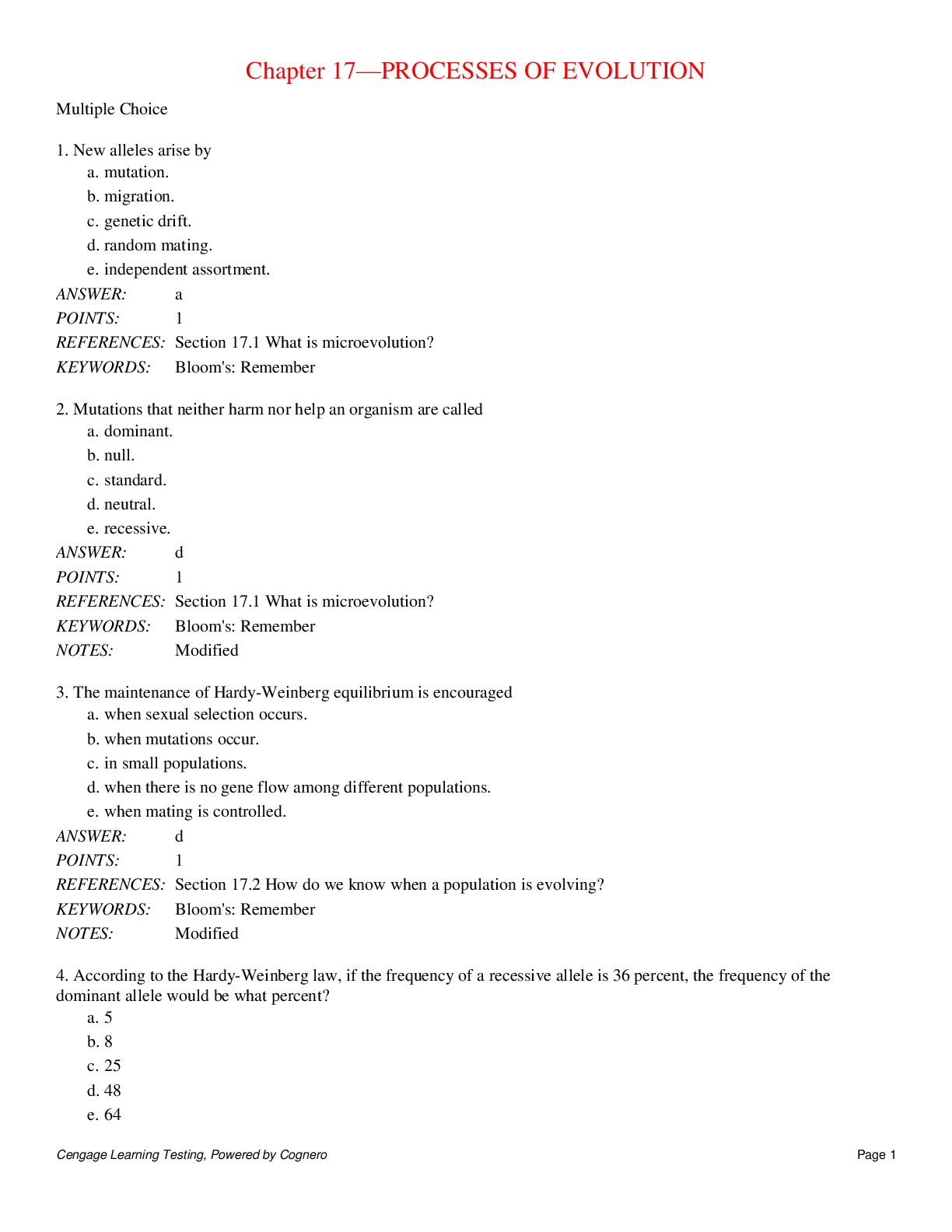
Reviews( 0 )
Document information
Connected school, study & course
About the document
Uploaded On
Nov 27, 2019
Number of pages
24
Written in
Additional information
This document has been written for:
Uploaded
Nov 27, 2019
Downloads
0
Views
83







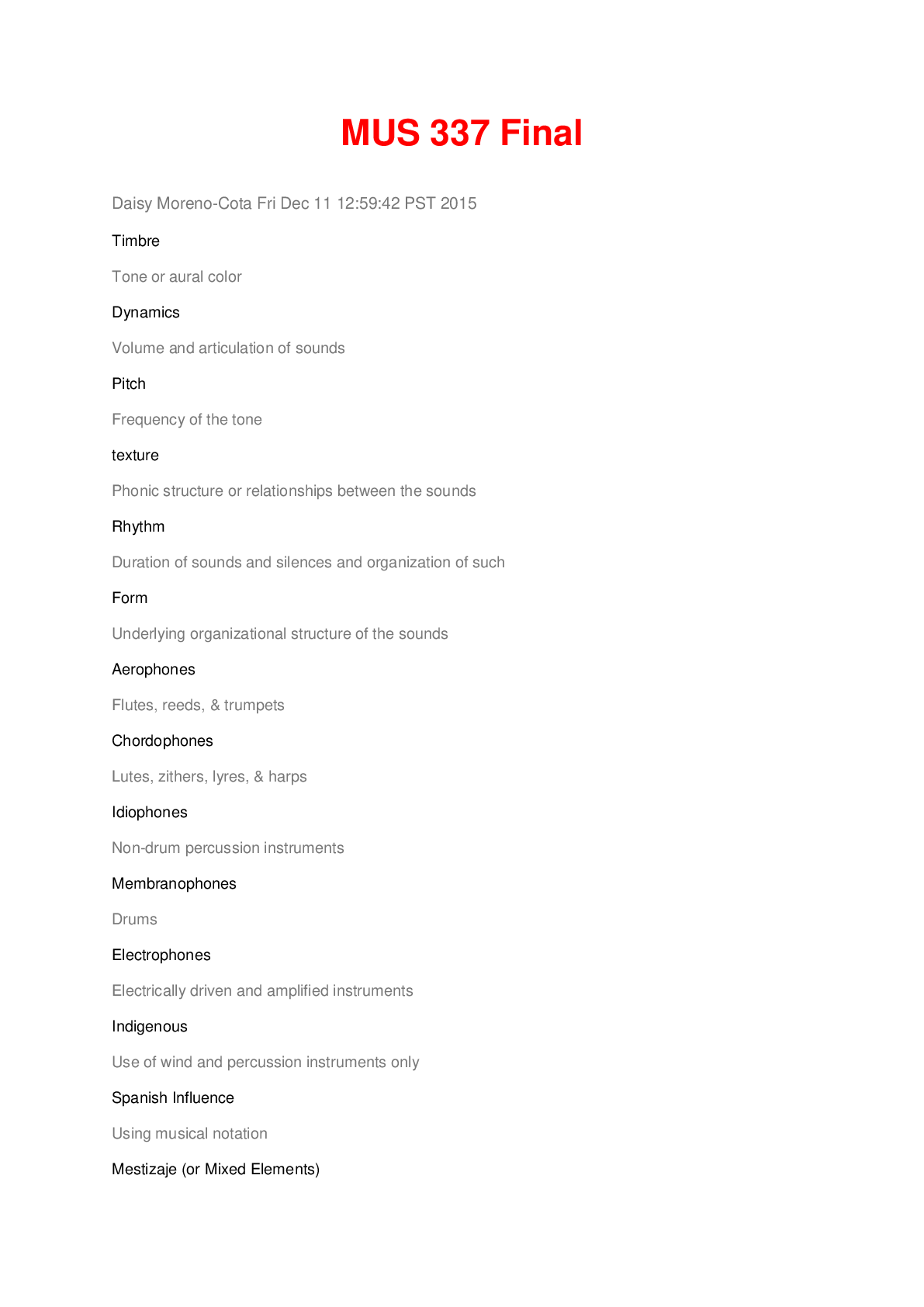




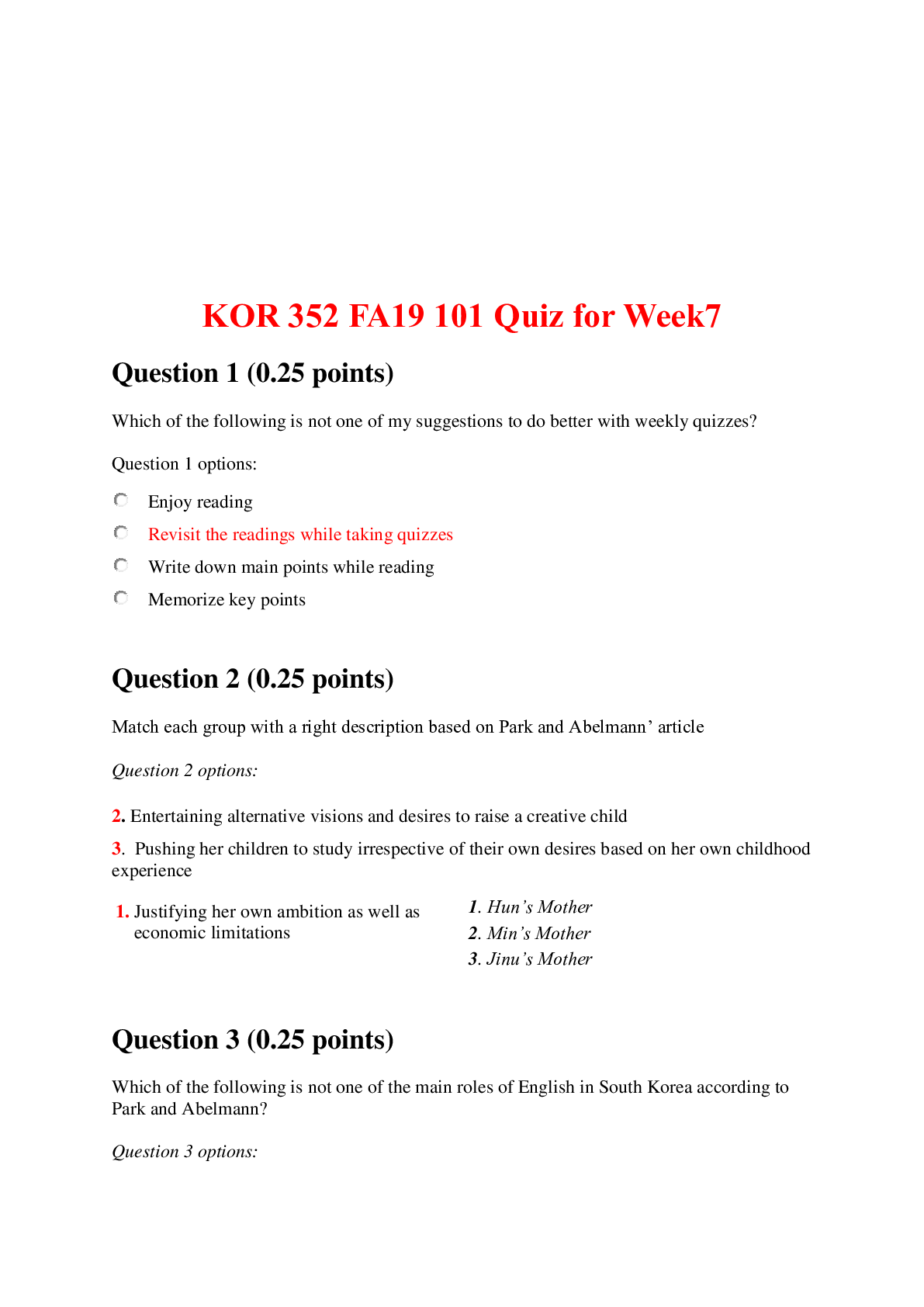


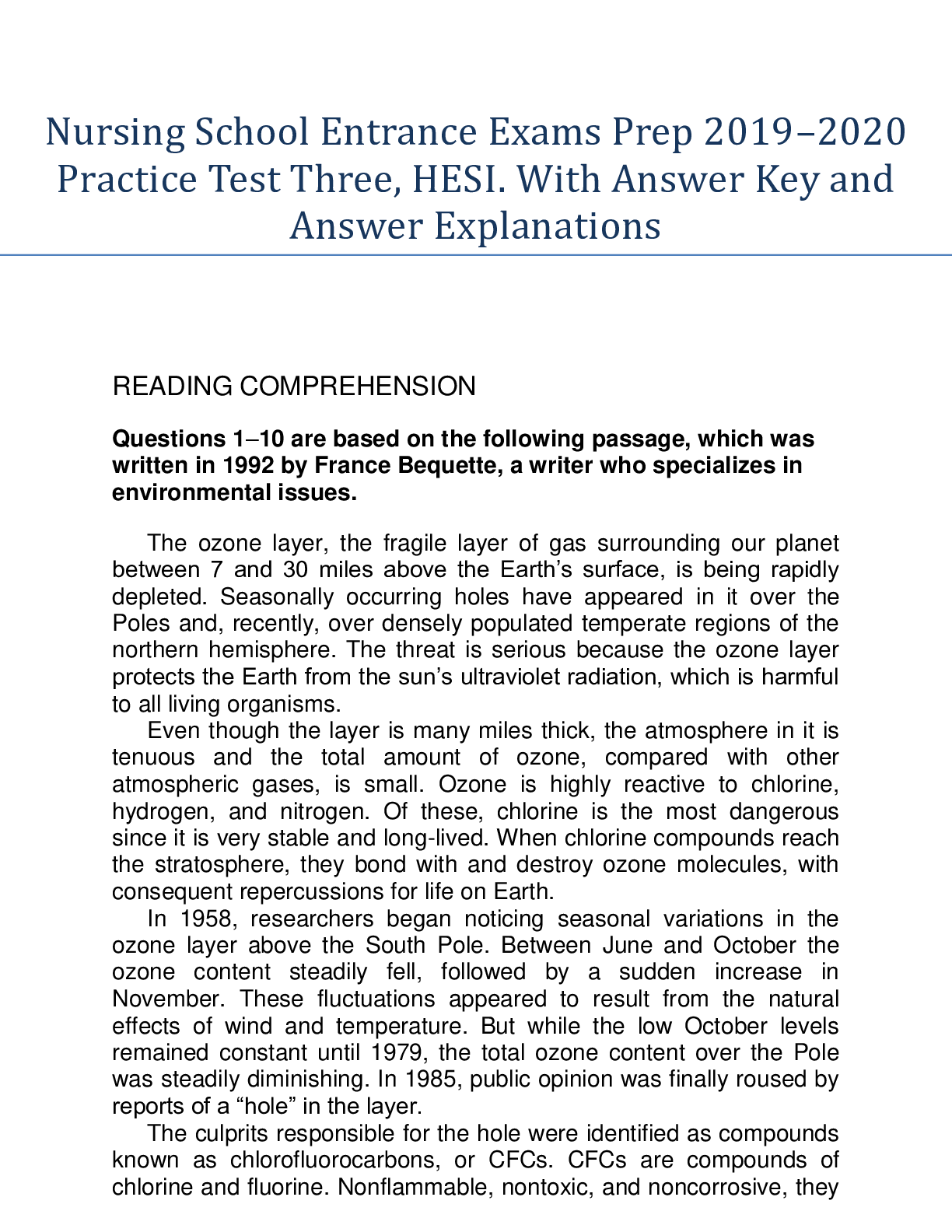

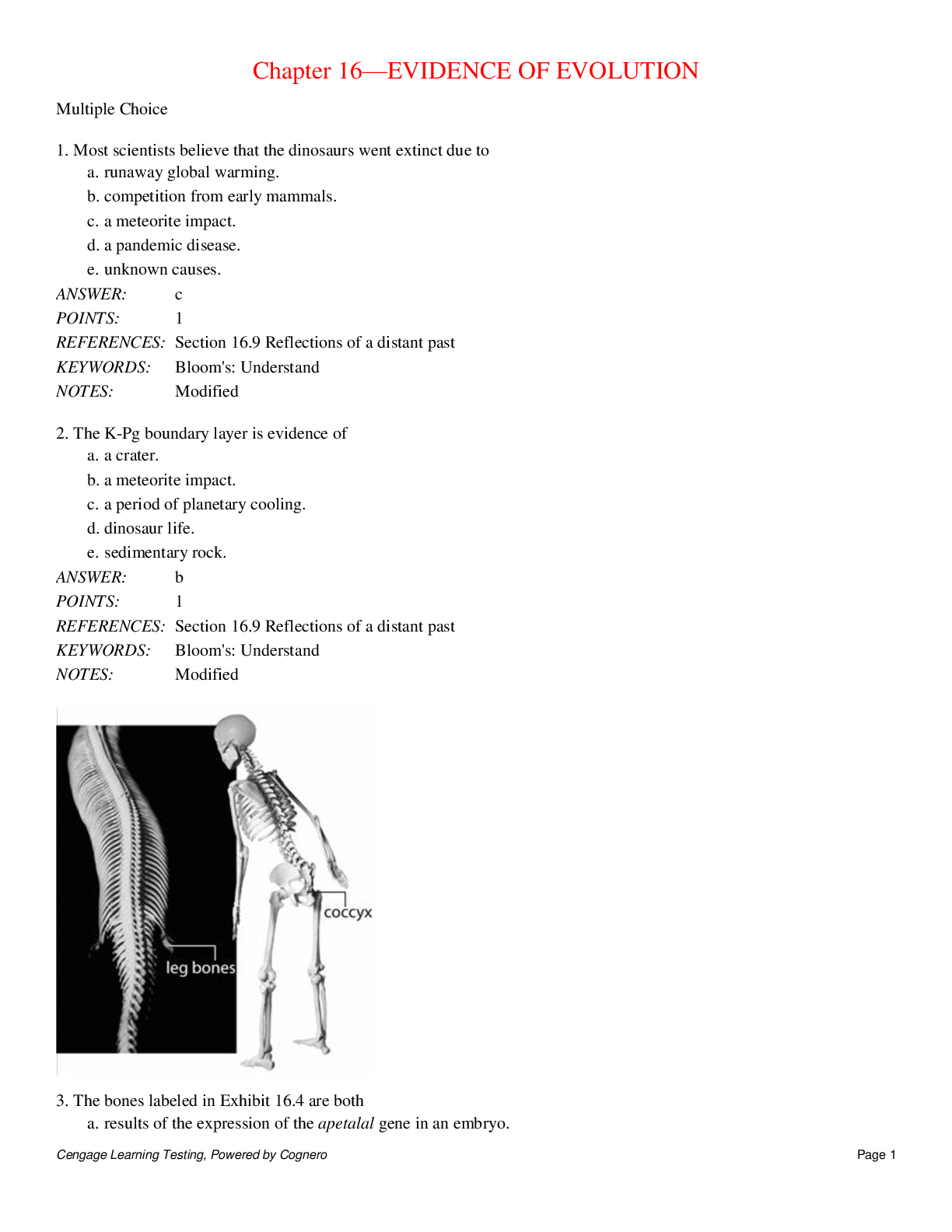


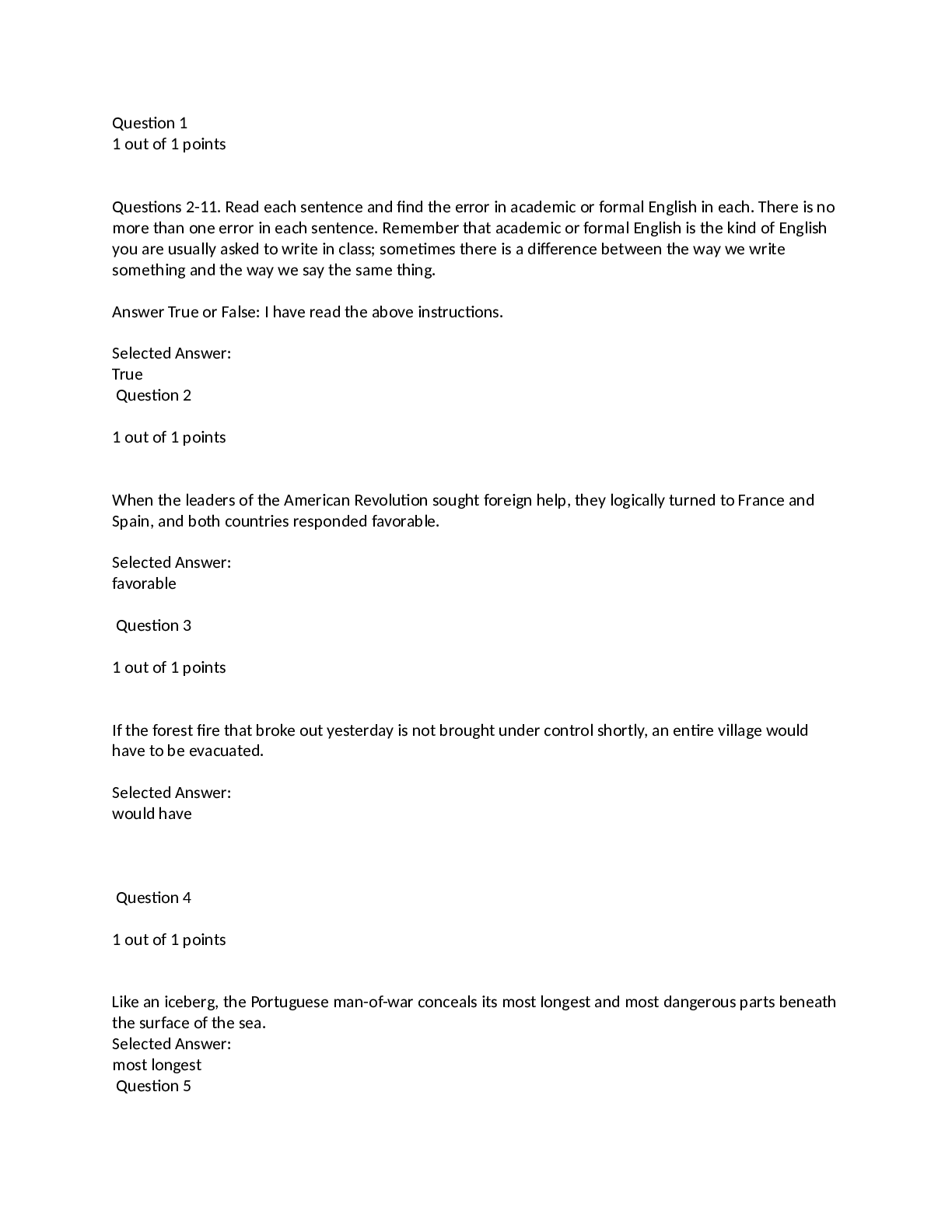
.png)
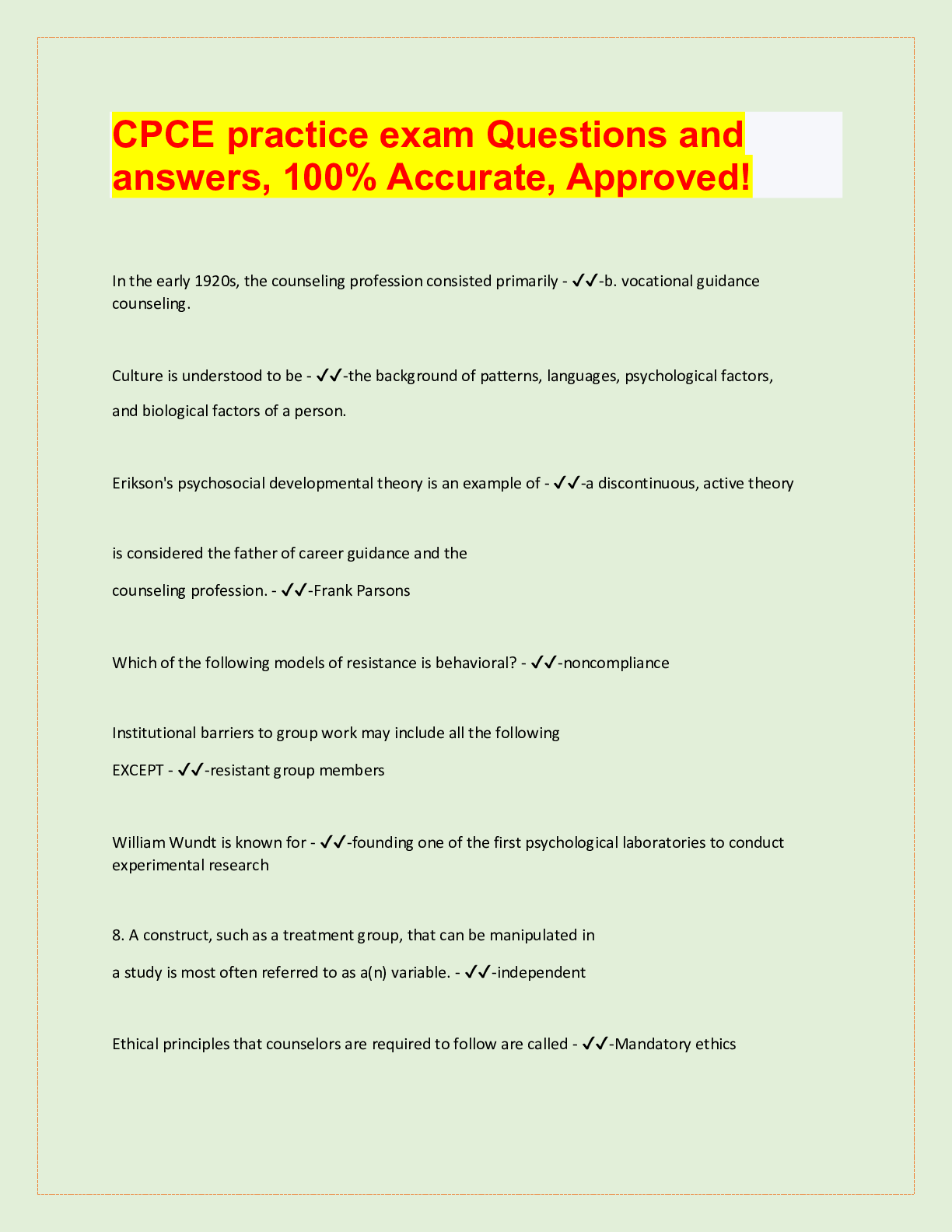
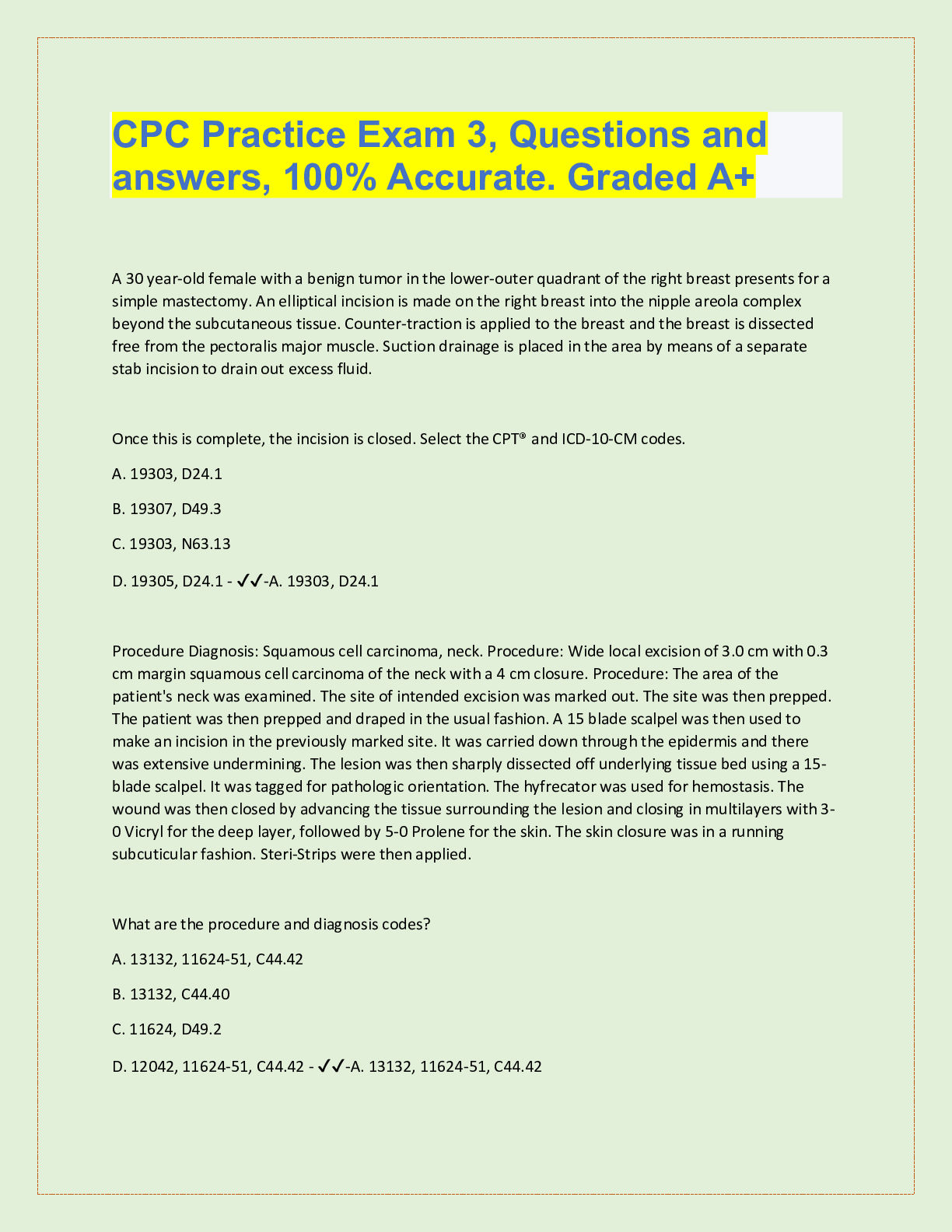
.png)


.png)


.png)

.png)
.png)
.png)

